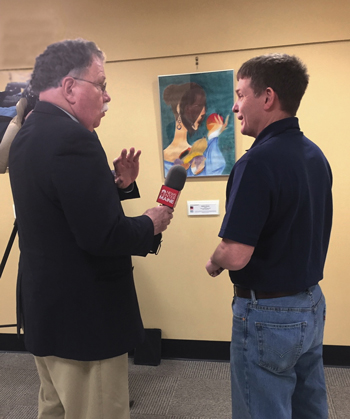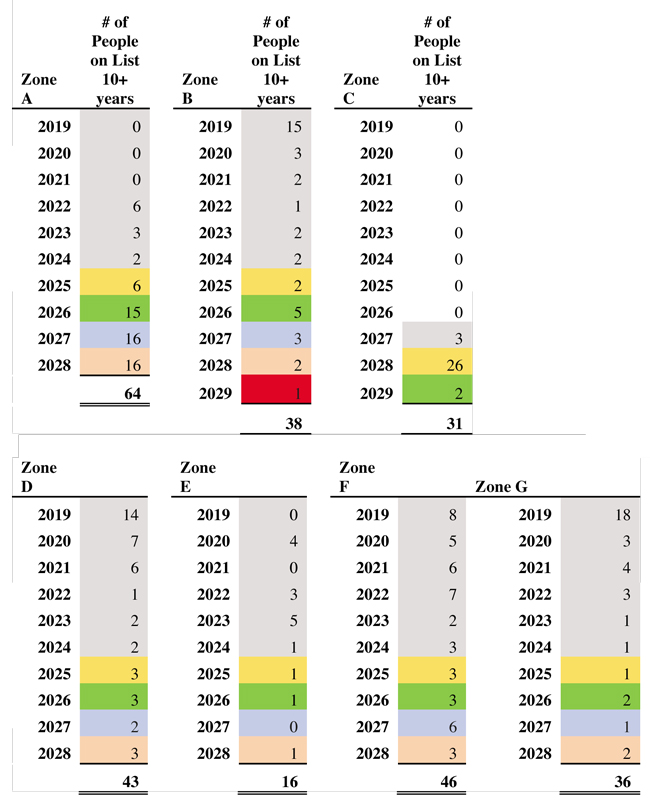Augusta Considers Controversial Lobster Waiting List Legislation
by Sarah Craighead Dedmon

Maine Lobstermen’s Association president Kristan Porter, Cutler, right. “We are being asked to significantly cut endlines out of the water, and the MLA along with other groups are trying to negotiate the best scenario we can get to keep this industry alive and on the face of it, it doesn’t look good if the state is loosening up requirements for entry.”
Maine’s 13-member Joint Standing Committee on Marine Resources is looking at a full agenda of fisheries-related legislation proposed for the first year of Maine’s 2019-20 biennial calendar.
House Marine Resources Committee Chair Rep. Joyce “Jay” McCreight (D-Harpswell) sponsored the first bill to draw large crowds in front of the committee last month in Augusta. The public hearing for LD 28, “An Act Regarding Access to Lobster Licenses,” was held on Tuesday, Feb. 5, drawing testimony for more than two hours.
The bill would grant licenses to new fishermen who have been on the waiting list for 10 or more years. In her opening remarks Rep. McCreight said 55 individuals in four of the state’s seven zones would immediately step into the fishery should LD 28 become law, including 15 applicants from Zone B (Gouldsboro to Tremont), 14 from Zone D (Ducktrap Harbor to Pemaquid), eight from Zone F (Cape Elizabeth to New Meadows River) and 18 from Zone G (Saco River to the New Hampshire line).
The remaining Zones A (Canadian border to Birch Harbor), C (Blue Hill to Stonington and offshore islands), and E (South Bristol to Bath) have no one waiting more than ten years.
Data compiled by the Maine Department of Marine Resources shows that there are 283 people on Maine’s lobster license waiting list. Overall lobster license counts have dipped from 7,100 in 1997 to 6,224 in 2018, for a license reduction of 12 percent statewide, or 876 fewer license holders.
Despite the reduction in active lobster licenses, Maine’s lobster landings have more than doubled from 47 million pounds in 1997 to 110 million pounds in 2017, with the overall cash value of the fishery more than tripling to almost $434 million.
“A lost generation of
fishermen need
their opportunity.”
– Jack Merrill,
lobsterman,
Mt. Desert
“As I’ve talked to fishermen around my district, people have various opinions,” said Rep. McCreight. “but there’s frustration about long waits, and this felt like something that we could explore and see if there’s a way to help people who have been waiting so long to get in.”
Fishermen testifying in support of the bill shared stories of long years spent as sternmen waiting their turn, of children getting their licenses sooner than their parents, and of younger fishermen leaving the state to work rather than wait for their license to come through.
Jack Merrill of Mt. Desert said he has a son on the waitlist, and that the original concept of the waitlist was to let people into the fishery, but “no one expected long waits.”
“Even if this bill passes, as far as I can tell there’s still no job in Maine that would require a longer waiting period,” said Merrill. “I fought all my adult life to make this fishery better, and it is better. But the current waitlist situation puts a strain on our fishery that needs to be cleaned up.”
“A lost generation of fishermen need their opportunity,” said Merrill.
Opposition
“The MLA hears all the
testimony brought forward
today, but it’s based on
the industry that we have,
not the one that we could have.”
– MLA President Kristan Porter,
Cutler
Opponents to LD 28 focused on the region’s ongoing bait shortage, made more dire by the recently reduced herring quotas, and new federal whale rules which could reduce the number of traps fishermen can hold.
Captain Julie Eaton, chairman of the Maine Lobstering Union’s legislative committee, said that the MLU’s membership was opposed to LD 28, and that the power to decide entry to the fishery should remain with the individual zone councils. Eaton also said the DMR should encourage some zones to reconsider how they determine entry.
“After examining the data compiled and provided by DMR, it is apparent that the zones with the longest waiting lists are the zones that have been using trap tags as currency instead of licenses in their exit ratios,” said Eaton.

Zones D, E, F, and G have historically used a trap tag ratio. Today zones D, F and G have a ratio of 1:4,000 tags. Fishermen point out that although an active commercial lobsterman will normally carry 800 traps, there are also many who only carry 100. This means that more than five licenses could leave the fishery for every one license issued in those zones. In 2017 Zone E changed to a 1:5 license ratio.
Eaton said that according to the DMR’s data, the number of license holders in Zones D-G have gone down between 20 and 36 percent since 1997. Conversely, the number of license holders in Zones A, B and C, which all utilize a license exit ratio, have risen between 8 and 23 percent in the same period.
Maine Lobstermen’s Association President Kristan Porter of Cutler said the MLA’s board met the day before and ultimately voted to oppose LD 28 based in part on “industry changing” regulations possibly coming down from the federal government regarding whales and the changes to the herring quota.
“The MLA hears all the testimony brought forward today,” said Porter, “but it’s based on the industry that we have, not the one that we could have.”
“We are being asked to significantly cut endlines out of the water, and the MLA along with other groups are trying to negotiate the best scenario we can get to keep this industry alive,” said Porter, “and on the face it doesn’t look good if the state is loosening up requirements for entry.”
Neutrality
Director of Marine Policy Deirdre Gilbert spoke on behalf of the DMR, and said the department is neither for nor against LD 28, and is sympathetic to the frustration of people on the waiting list. “We certainly understa
“The waiting list
is a fraud”
– Jim Anderson,
who favored LD 28.
Anderson is a
Zone D fisherman.
Gilbert went on to say that in the last six months it’s become clear that Maine will face “an almost incomprehensible shortage” of bait, referring to drastic cuts in the federal herring quota.
Two days after this hearing, the National Marine Fisheries Service announced the 2019 herring quota will be reduced by 70 percent from 2018’s quota.
“We can appreciate why existing license holders would object to changes that would allow significant increased entry at this time,” said Gilbert.
As of press time the committee’s first work session on LD 28 was tentatively scheduled for late February.
“It’s very possible we’ll have more than one work session, which is not unusual on a big issue,” said Rep. McCreight.
• • • • • •
Additional Waiting List Comments
“The waiting list is a fraud,” said Jim Anderson, who favored LD 28. Anderson is a Zone D fisherman who said he’d been on his zone’s list for more than nine years.
Anderson said the industry can accommodate long-time waiters because numerous licenses aren’t actively used.
Evan Thompson, a Zone G license holder, said some people in his area have been on the waiting list for a decade or more. Would-be license-holders end up leaving the fishery because they can’t get a license, he said.
“There’s no hope for these people,” he said. “These guys had a dream and they ended up leaving.”
Joshua Kane of Bar Harbor said he’s a deckhand who’s been on the Zone B waiting list for nine years. He said he wasn’t looking to have the fishery be wide open, but that he just wanted a chance.
“When I started, I thought I had a reasonable path. It was shifted halfway through the program,” he said, referring to stricter entry ratios. “I don’t think anyone should be excluded from this business for more than a decade.”
“I believe in the future of this industry and I believe the people on this list will have a positive impact toward the future of the industry,” said John Holdsworth, also of Bar Harbor and also on the waiting list. Holdsworth said he’s third man on his boat and has been unable to obtain a license, while fishermen younger than he is went through the student program, have their licenses, and earn a lot more.
“I don’t see it as fair for the growth of the industry and for the mindset of everyone who is part of the whole,” he said.
According to written testimony provided by Deirdre Gilbert, the Department of Marine Resources’ director of state marine policy, the issue of entry into Maine’s lobster fishery was last debated in depth in the spring of 2016, when then-Rep. Walter Kumiega submitted LD 1503, proposing modifications to lobster licensing and limited entry. A number of changes were made that have affected entry over the past two licensing years.
— Laurie Schreiber
